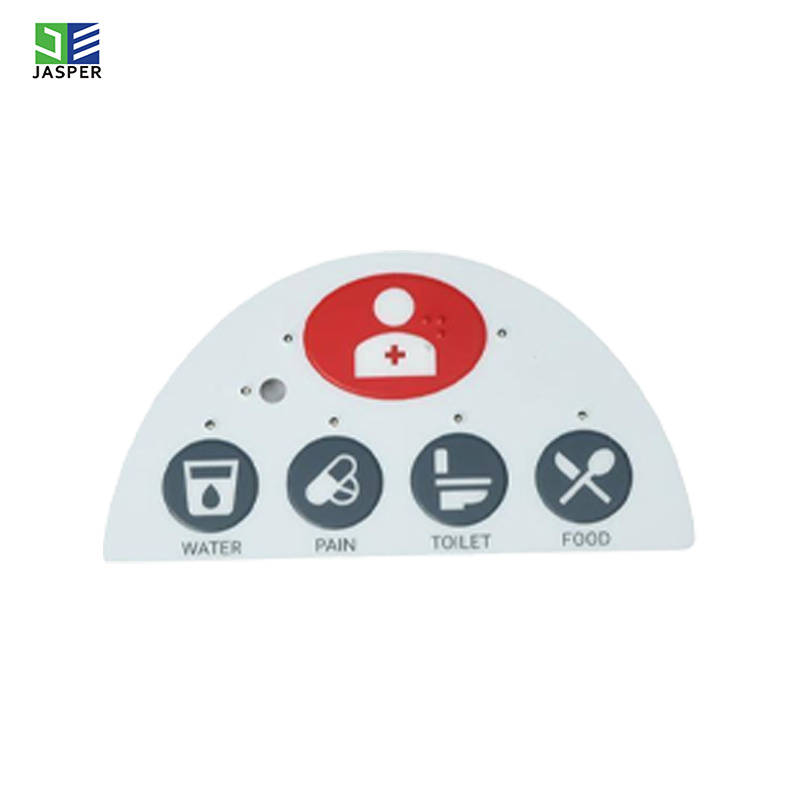Membrane Switch Cost in 2025: Factors & How to Save
Time:
2025-10-28
This guide explains the main cost drivers for custom membrane switches in 2025 and how JASPER helps reduce unit price through design-for-cost, proper adhesive selection, optimized backlighting, and better panelization—while maintaining reliability and compliance.

Cost Breakdown: What You Pay For
- Stack-up & Layers: Overlay, circuits (top/bottom), spacer, rear adhesive; domes/backers add parts and processes.
- Size, Shape & Yield: Larger footprints and irregular outlines waste more material and reduce panel yield.
- Graphics & Windows: Extra colors, tight tolerances, and clear/tinted windows increase printing and QA time.
- Backlighting: LED/EL/LGF choices change components, assembly, and testing scope.
- Shielding & IP Rating: EMI/ESD layers, gaskets, edge sealing and validation tests add cost.
- Adhesives & Substrates: Matching adhesive system & thickness to your panel surface avoids rework and scrap.
- Volume, Tooling & Lead Time: Higher volumes amortize tooling; realistic lead times enable cost-efficient scheduling.

Typical Feature Impact (Qualitative)
| Design Choice | Cost Impact | Notes |
|---|---|---|
| Tactile domes vs non-tactile | ▲ | Domes add BOM and assembly; choose force/travel appropriate to UX, not over-spec. |
| Backlighting: LED | ▲ | Bright, long life; needs LEDs, resistors, light management, and thermal checks. |
| Backlighting: EL | ▲ | Ultra-thin/even glow; requires an inverter; lifetime & duty cycle considerations. |
| Backlighting: LGF (Light Guide Film) | ▲ | Thin and uniform with side LEDs; great for icons/logos in thin builds. |
| EMI/ESD shielding | ▲ | Printed carbon/foil + ground; add where EMC or safety requires. |
| Adhesive thickness (e.g., 467MP vs 468MP) | ↔ / ▼ | Match to substrate: thicker adhesive improves wet-out on textured/powder-coat; avoids rework. |
| Panelization & nesting | ▼ | Better material utilization = lower unit cost. |
| Color count (inks) | ▲ | Consolidate spot colors; consider digital for small batches. |
How Backlighting Changes Cost
Backlighting adds materials, assembly and testing — but each technology has different trade-offs:
- LED: Highest brightness and longevity; BOM and thermal checks increase cost moderately.
- EL (Electroluminescent): Ultra-thin, even glow; requires an inverter and has finite luminous life.
- LGF (Light Guide Film): Uses side LEDs to distribute light uniformly in thin stacks — ideal for icons/logos.

Adhesives: Pick the Right Thickness, Save the Rework
For high-energy substrates, JASPER commonly specifies industrial adhesive families (e.g., 200MP). Thinner variants fit smoother, high-energy panels; thicker variants improve wet-out on textured or powder-coated surfaces. Validate on your substrate to prevent peel or edge-lift in field use.
Design-for-Cost Tips
- Standardize tail pitch/pin count to fit common ZIF/FFC connectors.
- Design for panelization: avoid extremely irregular outlines; keep reasonable spacing.
- Limit unique ink colors and small isolated windows; combine windows where possible.
- Choose the lowest necessary IP rating and add EMI/ESD only where required.
- Match dome force to use case (e.g., gloved operation) — don’t overspec travel/force.
- Provide controller connector part number to lock ZIF/FFC thickness and pinout early.
How to Get a Faster, More Accurate Quote
- Attach drawings (DXF/DWG/PDF/Gerber) with dimensional tolerances.
- Specify stack-up, backlighting, shielding, desired IP rating, and target lifecycle.
- List substrate and surface finish; note chemicals/UV/outdoor exposure.
- Provide tail pitch/pins and controller connector P/N.
- Share estimated volumes and schedule (prototype → pilot → mass production).
Related Resources
FAQ
What impacts the price of a membrane switch the most?
Stack-up complexity, size/shape (yield), graphics/windows, backlighting, shielding/IP targets, adhesives/substrates, and volume/tooling typically dominate cost.
How does backlighting affect cost?
LED adds components and assembly but offers long life and brightness; EL is ultra-thin with even glow but requires an inverter; LGF enables uniform thin lighting using side LEDs.
How can I reduce unit price without sacrificing reliability?
Standardize tail pitch/pinout, panelize for yield, minimize unique colors/windows, choose appropriate dome force, and avoid over-specifying IP rating or shielding.
Can JASPER sign an NDA before sharing drawings?
Yes. We routinely work under NDA for medical/industrial projects. Please note the NDA request in your RFQ.
Relevant news
